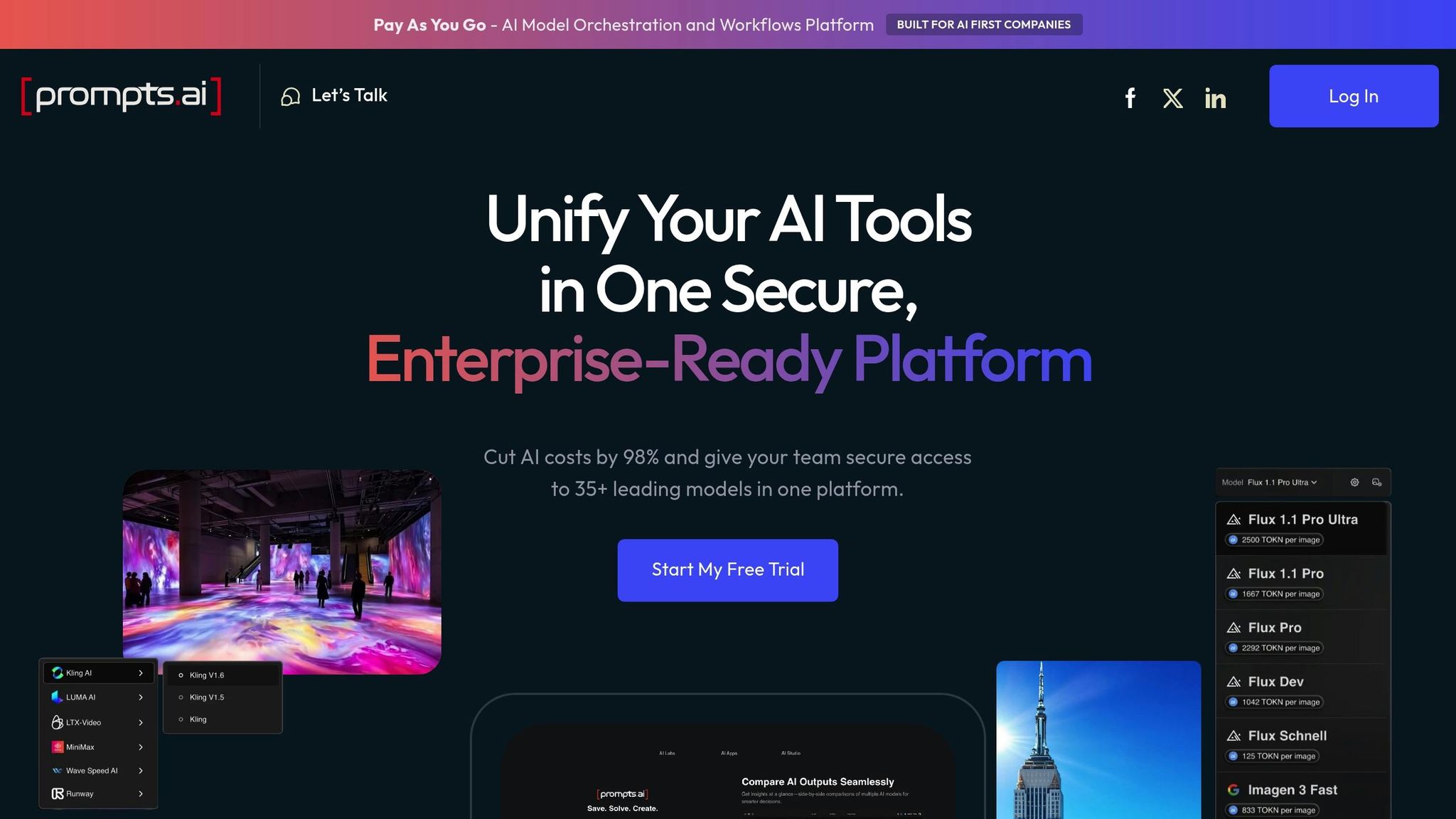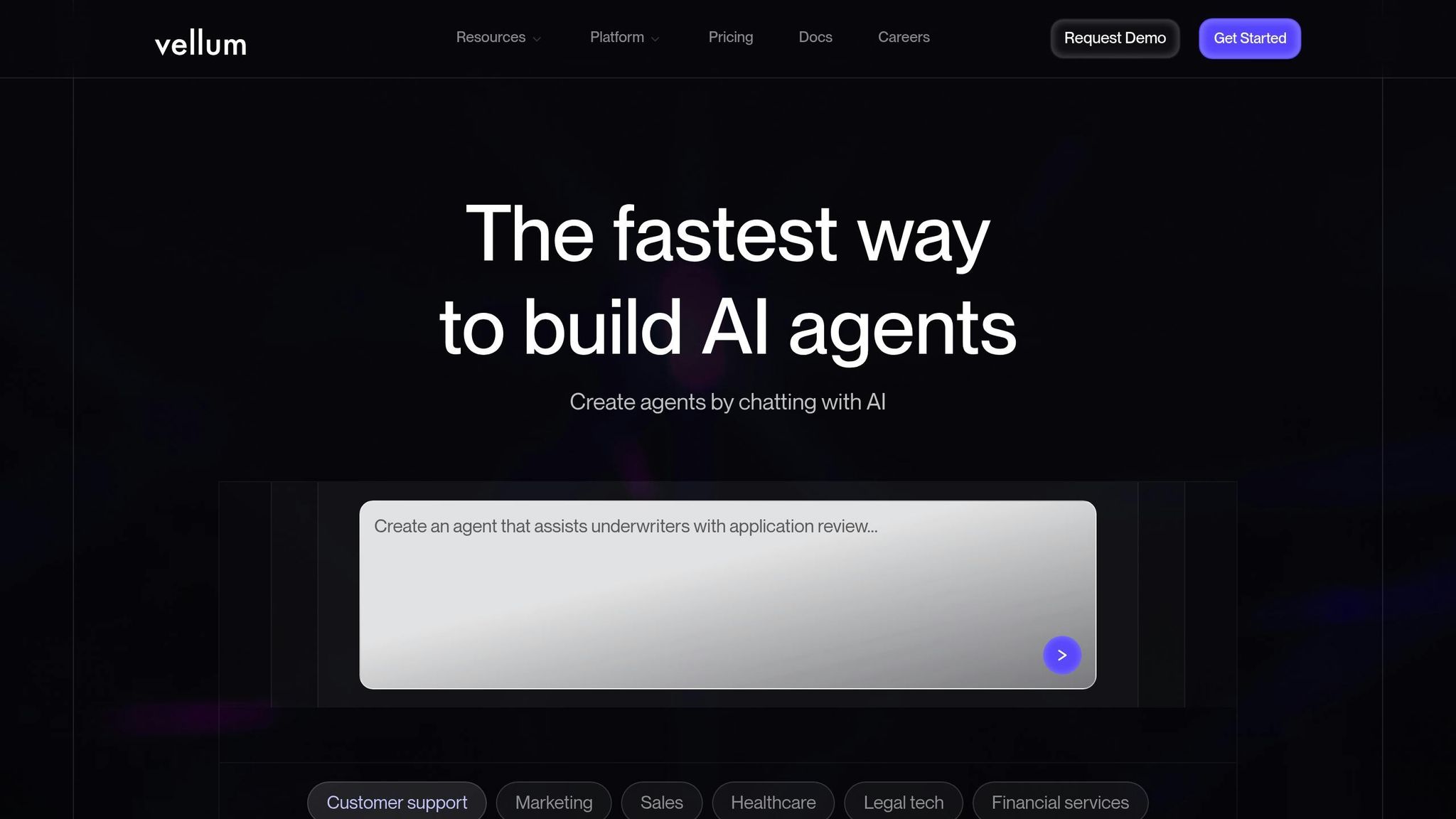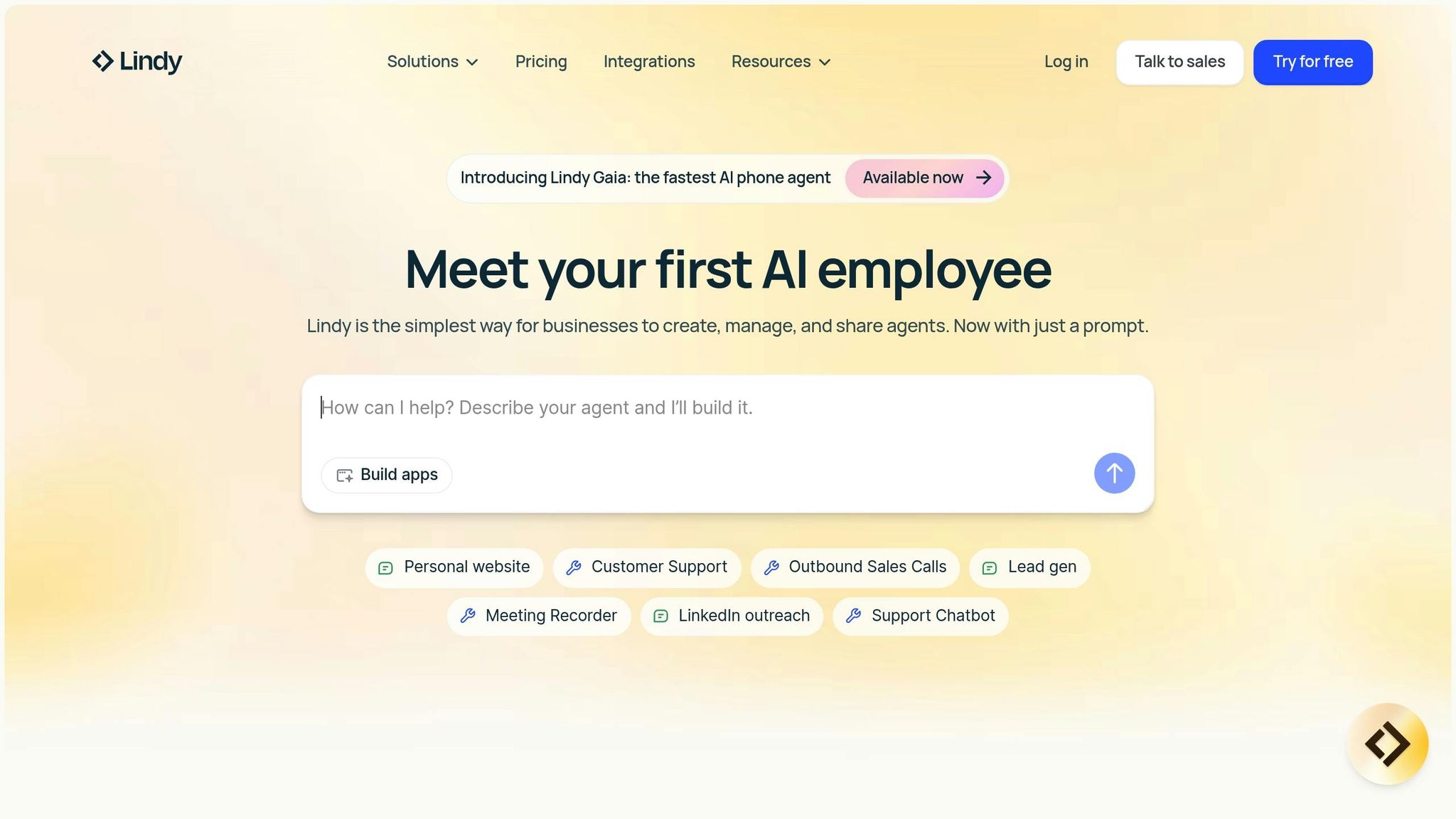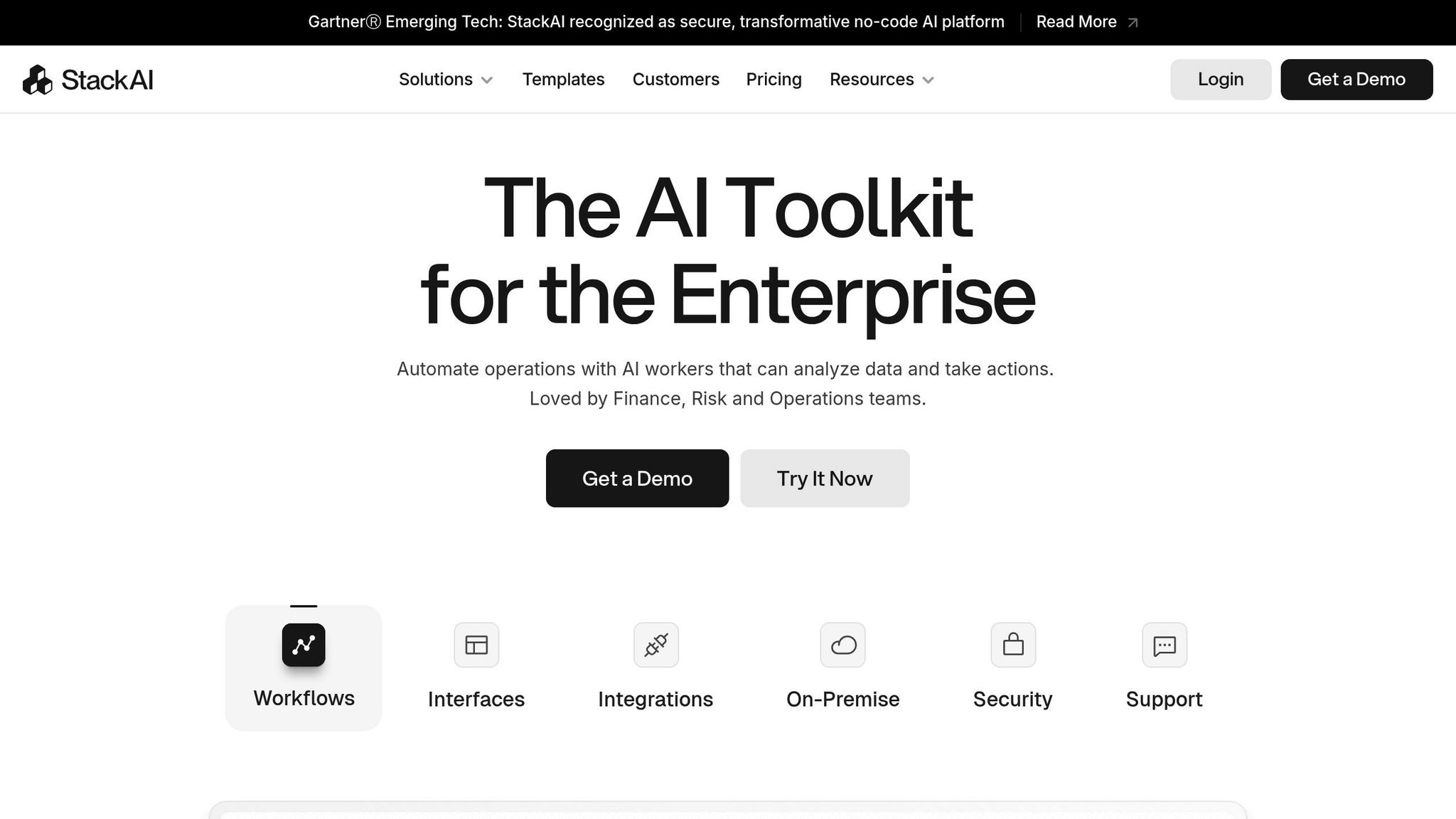
AI costs are rising, and fragmented tools make workflows inefficient. Platforms like Prompts.ai, n8n, and others are solving these challenges by centralizing tools, offering transparent pricing, and ensuring security. Here's what you need to know:
Quick Comparison:
| Platform | Cost Savings | Integration Strength | Security | Scalability |
|---|---|---|---|---|
| Prompts.ai | Up to 98% savings | 35+ AI models | Enterprise-grade | High |
| n8n | Open-source, no fees | Extensive connectors | Strong | Medium-High |
| Vellum AI | Usage-based pricing | Developer-focused | Limited info | High |
| Lindy | Subscription model | Moderate integrations | Standard | Medium |
| Stack AI | Unknown | Unknown | Unknown | Unknown |
Choose the platform that aligns with your needs - whether it's cost control, security, or integration flexibility. These tools are reshaping how businesses manage AI workflows.

Prompts.ai is a powerful AI orchestration platform designed to tackle the challenges American businesses face in managing AI workflows. By bringing together over 35 top large language models - including GPT-5, Claude, LLaMA, and Gemini - into one streamlined interface, it simplifies the complexities of handling multiple tools and subscriptions.
One of Prompts.ai's standout features is its ability to connect various AI models and processes with minimal hassle. Through its unified platform, teams can compare model performance side by side, test different approaches, and refine workflows - all without the headache of managing multiple subscriptions.
This flexibility is particularly useful for businesses that need to switch between models based on factors like cost, performance, or specific use cases. By seamlessly integrating diverse models, Prompts.ai not only simplifies operations but also drives smarter cost management.
Prompts.ai’s pay-as-you-go TOKN credit system eliminates recurring subscription costs and can slash AI software expenses by as much as 98%. Built-in FinOps tools provide real-time cost tracking and actionable optimization tips.
With detailed cost transparency, organizations can monitor token usage across teams and models, empowering CFOs and IT leaders to make informed decisions. Spending limits and budget alerts help prevent unexpected overruns, while these financial controls work hand in hand with the platform’s security and scalability to deliver a comprehensive solution.
Security is at the core of Prompts.ai. The platform ensures compliance with industry regulations and internal policies by offering audit trails for every AI interaction.
Its centralized governance approach allows businesses to apply consistent security measures and compliance controls across all workflows. This reduces the risks associated with data breaches or regulatory violations that can arise when using disconnected AI tools with varying security standards.
Prompts.ai is built to grow with its users, whether they’re small teams or Fortune 500 companies. Adding new models or users takes just minutes, making it easy to scale as needs evolve. The Prompt Engineer Certification program equips teams with the skills they need to develop in-house AI expertise.
The platform also provides robust support for scaling AI adoption. With hands-on onboarding and enterprise training, organizations can hit the ground running and avoid common pitfalls associated with deploying fragmented AI tools. This ensures that businesses can fully capitalize on their AI investments from day one.

Information about Vellum AI is scarce, with limited public documentation available to verify its features, integrations, cost-saving strategies, security measures, or scalability. Early signs suggest an emphasis on automation, but concrete details have yet to be disclosed.
In contrast to platforms like Prompts.ai, which offer detailed overviews, Vellum AI's current profile remains vague, encouraging a measured outlook. As more information becomes available, a clearer understanding of how Vellum AI might align with or enhance cost-saving approaches seen in other platforms will be possible.
n8n is an open-source platform designed for workflow automation, enabling teams to connect various applications and services with ease. Its intuitive visual builder empowers users to craft automation sequences while retaining full control over their AI-powered processes.
n8n bridges the gap between different systems through a robust library of pre-built integrations, webhook functionality, and REST API support. It integrates effortlessly with widely-used AI services, databases, cloud storage platforms, and business tools, making it easy to enhance existing tech stacks without replacing current solutions. The platform also supports custom integrations for proprietary systems or emerging AI technologies that lack dedicated connectors. With options for both cloud-based and on-premises deployments, organizations have the flexibility to manage their automation infrastructure in a way that suits their needs. This adaptability not only streamlines operations but also helps reduce costs.
As an open-source platform, n8n offers a budget-friendly alternative to proprietary automation tools. Organizations can self-host the platform, avoiding the per-workflow or per-execution fees often associated with other services. Its fair-code licensing allows free internal use, requiring payment only for commercial redistribution. By optimizing workflows, n8n minimizes server resource consumption, enabling multiple automation processes to run efficiently on standard hardware setups. This leads to noticeable savings in infrastructure expenses.
n8n prioritizes security with features like granular access controls and advanced user management, ensuring sensitive workflows and data are accessible only to authorized team members. Role-based permissions enhance collaboration without compromising security. For organizations with strict compliance needs, the self-hosted option ensures all workflow data stays within their infrastructure, addressing data sovereignty and meeting regulations like GDPR and HIPAA. Additional features, such as encryption for sensitive data and secure credential management for API keys and authentication tokens, further strengthen its security framework. These measures make n8n a reliable choice for scaling operations securely.
The platform's architecture is designed to scale with ease, supporting both horizontal and vertical expansion. Its queue system efficiently handles workflow execution, preventing bottlenecks during high-demand periods. An active community of contributors continuously enhances the platform and adds new integrations, ensuring n8n remains aligned with the latest AI advancements and evolving business needs. This scalability makes it a future-ready solution for growing automation demands.

Lindy is an AI-driven platform focused on streamlining workflow management through automation. While specific details about its features and performance remain limited, it is positioned to adapt to the evolving landscape of AI automation.
Due to the scarcity of verified information, a thorough analysis of Lindy’s integration capabilities, cost-effectiveness, security measures, and scalability isn’t yet possible. However, its emphasis on automation hints at the potential for delivering cost-saving solutions, akin to those offered by platforms like Prompts.ai and n8n.
Similar to other tools in this space, Lindy is designed to address inefficiencies in workflows. As more information becomes available, its unique strengths and competitive edge may become clearer.

Stack AI is a relatively new platform, and public information about its technical features and cost-saving strategies is currently limited. Given this early stage, users interested in its capabilities will need to reach out directly to the company for specifics on areas like cost efficiency and scalability.
At this point, there’s no detailed information available about its pricing structure, infrastructure design, or how it performs under the demands of enterprise-level workloads. Without these technical details, its ability to lower operational costs or handle large-scale needs remains uncertain.
Like many platforms in their early phases, the lack of comprehensive documentation highlights the importance of gathering clear insights before committing to its use. As the platform evolves, more concrete details may emerge to address these gaps.
Continuing from our earlier discussion on AI workflow challenges, let’s dive into how different platforms tackle cost, integration, security, and scalability. Each option brings its own strengths and compromises, making it vital to assess which aligns best with specific needs.
Prompts.ai excels with its transparent pricing and access to over 35 leading large language models. Its pay-as-you-go TOKN system, combined with FinOps controls, reduces costs while maintaining clarity. Enterprise-grade security and governance make it a reliable choice for handling sensitive data, even for Fortune 500 companies.
Vellum AI caters to developers with its robust APIs and focus on production-ready deployments. It’s a solid choice for teams iterating quickly on AI applications, thanks to its strong integration capabilities. However, its steep learning curve might pose challenges for non-technical users seeking immediate results.
n8n offers unparalleled flexibility through its open-source design and extensive connector library. Its visual builder empowers non-developers to design automation flows, while the self-hosting option ensures full control over data. That said, organizations may need to invest in technical expertise for setup and ongoing maintenance.
Lindy emphasizes simplicity, making AI automation accessible to business users without technical expertise. Its conversational interface and pre-built templates speed up deployment, especially for customer service and content-related workflows. However, its streamlined approach may not suit organizations with highly specialized technical needs.
Stack AI remains in its early stages, with limited public information on its capabilities, pricing, and performance. While it might appeal to those looking to explore cutting-edge solutions, its emerging status brings uncertainties around reliability, scalability, and long-term viability.
The growing trend of multiple specialized models and autonomous agents has made interoperability a critical factor in AI workflows. Modern architectures demand seamless integration between open-source tools, proprietary systems, and hybrid cloud environments. Interoperability is becoming the essential "glue" for managing complex AI ecosystems.
The table below summarizes the key features of these platforms for easy comparison:
| Platform | Cost Optimization | Interoperability | Security | Scalability | Best For |
|---|---|---|---|---|---|
| Prompts.ai | Excellent – Pay-as-you-go, 98% cost reduction | Strong – 35+ leading LLMs | Enterprise-grade | High | Large enterprises, multi-model workflows |
| Vellum AI | Good – Usage-based pricing | Strong – Developer-focused APIs | Good | High | Technical teams, rapid iteration |
| n8n | Excellent – Open-source option | Excellent – Extensive connectors | Variable | Medium-High | Complex integrations, custom workflows |
| Lindy | Good – Subscription model | Moderate – Key integrations | Standard | Medium | Business users, simple automation |
| Stack AI | Unknown | Unknown | Unknown | Unknown | Early adopters, experimental use |
When choosing a platform, organizations should prioritize those offering pre-built connectors for widely-used enterprise systems like SAP, Salesforce, Oracle, SharePoint, and Microsoft 365. Adopting platforms that support open standards such as REST APIs or SQL interfaces can significantly reduce development time and deployment challenges.
Conducting a technology readiness assessment is also crucial to identify integration gaps, especially when dealing with outdated legacy systems. This preparation is key to unlocking the full potential of unified AI orchestration, as discussed earlier.
As we look toward 2025, selecting the right AI workflow platform has become a pivotal decision for long-term success. With 92% of companies planning to expand their AI investments in the next three years, yet only 1% considering themselves "mature" in AI deployment, the choice you make today will shape your organization's ability to lead or lag in this rapidly advancing field. This analysis highlights the strengths of various platforms tailored to organizations at different stages of AI adoption.
Prompts.ai offers unmatched cost control and governance for enterprises managing multiple AI workflows. For technical teams focused on rapid development and developer-centric tools, Vellum AI provides powerful APIs and production-ready features. n8n is ideal for organizations that require maximum flexibility and control, particularly those with complex integration needs and the technical expertise to utilize its open-source framework. Lindy, with its conversational interface, simplifies deployment for business users, reducing friction and making AI more accessible. Meanwhile, Stack AI is better suited for experimental and exploratory use cases.
The key takeaway is to align platform capabilities with your organization's unique needs. Unified orchestration and adaptable integration remain essential for successful AI deployment. Companies should seek platforms that offer seamless integration with existing tools, robust governance frameworks, and scalability to support growth. As modular AI systems - incorporating RAG, knowledge graphs, and AI agents - continue to evolve, your platform must support these advancements while keeping costs under control.
Employees are ready to embrace AI, and the responsibility now lies with leadership to accelerate adoption by focusing on practical, impactful applications. The right platform should remove obstacles, not create them. It should turn experimentation into consistent, compliant processes that deliver tangible business results. By making the right choice, organizations can streamline operations, address fragmented pricing and operational challenges, and unlock the full potential of AI for transformative impact.
Prompts.ai offers businesses the opportunity to save up to 98% on costs by uniting more than 35 AI models into one efficient and easy-to-manage platform. With real-time cost tracking powered by TOKN credits, companies gain complete visibility over their spending, making it easier to stay on budget. The platform also features advanced security protocols and fine-tuned resource management, cutting waste without compromising on performance or productivity.
When choosing an AI platform to balance cost reduction with growth potential, focus on three key aspects: interoperability, integration simplicity, and transparent pricing. Opt for solutions that smoothly integrate with your existing tools and systems while providing straightforward and competitive pricing.
Scalability plays a critical role in this decision. Evaluate how effectively the platform manages increasing data volumes, optimizes resource usage, and maintains consistent performance under different workloads. Additionally, consider the affordability of scaling cloud services or hardware as your requirements expand.
Selecting a platform with a track record of handling scalability and offering robust automation ensures efficient, adaptable AI workflows that align with your business's growth trajectory.
n8n's open-source approach gives businesses a cost-effective alternative by offering a free self-hosted version. This eliminates expensive licensing fees, allowing companies to reallocate their budgets toward infrastructure and operational needs - often managed with existing resources - further trimming costs.
For those seeking a managed solution, n8n provides cloud plans starting at just $24 per month. Even so, the core software remains free for internal use, making it a versatile and budget-conscious choice for organizations looking to optimize their AI workflows without the hefty price tags tied to proprietary tools.


